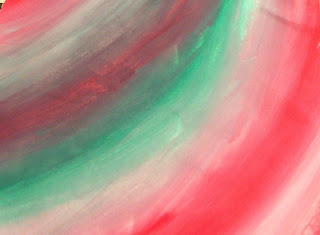A "Color Gradation" is a slow change from one color to another. There are many ways to accomplish this painting technique. Watch the video below to see Mrs. Nichols teach two different methods of creating a color gradation. To the right is a video clip of one of our 6th graders demonstrating her skills:
Color Schemes" are colors that look good together - they "match" each other. Sometimes they are called "Color Families." There are many sets of color schemes, including these three:
1. Monochromatic = using only one color plus its tints and shades (black and white) such as red, pink (a tint of red), maroon (a shade of red), or blue, navy blue (a shade of blue), baby blue (a tint of blue), etc. Here are some student examples:
2. Analagous = colors that are side by side on the color wheel such as orange, red, and purple or blue, green, and yellow. These colors are neighbors! This analagous painting by a 7th grader uses yellow, green, and blue:
3. Complementary = opposite colors on the color wheel such as red and green, or blue and orange, or yellow and purple. Complementary colors make each other stand out when placed next to each other in a painting, but if mixed will cancel each other out, creating a neutral. The sky is never more blue than it is in the fall, when there is a backdrop of orange leaves to emphasize the blue! Here are some non-objective complementary paintings by students:
Our objectives for yesterday and today are designed to get students to develop specific skills in working with paint. They are getting lots of practice; getting comfortable with this liquid medium that can sometimes be intimidating! Learning to do color gradients is a great way to explore paint and create beauty all at the same time.
DAILY OBJECTIVES:
1. I can create a series of three miniature paintings based on color schemes; monochromatic, analagous, and complementary.
2. I can practice the color gradation technique; blending one color slowly into another with no lines between colors.
Note: Students saved these miniature paintings and created greeting cards with them. One card was decorated as a "Thank You" card for a Hueytown police officer for the winter holidays.
 |
| Analagous and Complementary nonobjective paintings by an 8th grader |
For further exploring, here is an interesting website about optical illusions and color:
Optical Illusions, colorbasics.com
Also, check out this Adobe website about color schemes;
Color Wheel, adobe.com
or this one from designschool.canva.com......What is a "real life" scenario where I could use color schemes in the workplace? Designing websites is one example!
Website Color Schemes





